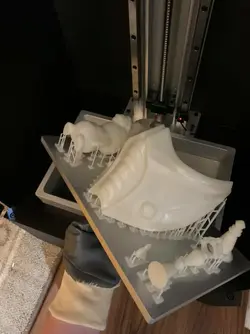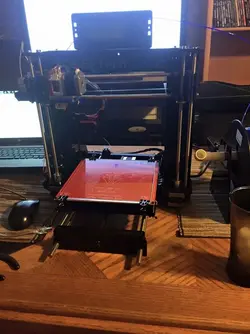Groundbreaking Discovery To Make Time Machines
- Thread starter Calc
- Start date
_Oz
Chrono Cadet
[QUOTE='Calc]Do please tell me more about the true AI you're talking about, I'm intrigued!
[/QUOTE]True AI is one that is able to think & learn for itself. There are learning bots out there, but none that have curiosity to learn things it never thought about learning before. Right now there's always a human to guide them in the right direction. Once it "wakes up" it's intelligence would become exponential as it sought to teach itself as much as it could.
^ The closest so far was Facebook's two machine learning bots, tasked with passing a ball back and forth with 0 instructions on language. They ended up inventing a language system of their own to complete the objective, and then were shut down.
-Oz
[/QUOTE]True AI is one that is able to think & learn for itself. There are learning bots out there, but none that have curiosity to learn things it never thought about learning before. Right now there's always a human to guide them in the right direction. Once it "wakes up" it's intelligence would become exponential as it sought to teach itself as much as it could.
^ The closest so far was Facebook's two machine learning bots, tasked with passing a ball back and forth with 0 instructions on language. They ended up inventing a language system of their own to complete the objective, and then were shut down.
-Oz
Einstein
Dimensional Traveler
'Alamo127]What is that? I'm guessing two coils because of the high voltage sound. Is the middle thing a magnet? Last said:I'm remembering this from years ago. So please forgive me if you find an old post that disagrees with me now. There is a neodymium magnet between two coils of wire. I was running pulsed square waves through the coils. I had designed the electronics to delay the timing of pulses between the two coils. So one coil is being pulsed on and off at a later time than the other coil. I had made the delay time variable. But I could watch both coil pulses on an oscilloscope. On the oscilloscope I could see that the observed motion occurred at 90 degrees phase delay and a direction reversal at 270 degrees phase delay. At 0 degrees and 180 degrees no motion at all. The frequency of the pulses was very low. Below 200 hertz. I had adjusted that in a low range to avoid two much back impedance from interfering with the operation. I did try higher frequencies with a severe reduction in the observed effect.
This all came about thanks to Bob Lazar's description of how the ET's were controlling the gravity wave amplifiers. I didn't have gravity waves to play with. But I could construct something with magnetic waves. So I did with surprising results.
Einstein
Dimensional Traveler
'Alamo127]Also said:Quite a while ago I was building a mechanical propulsion drive using gyroscopes. I did have some interesting ideas to work with. But I decided to give up because it was getting too expensive to keep going in the direction my experiments suggested. I was spinning the gyroscopes up to 30,000 rpm. When I applied a turning torque to the gyroscope the forces involved managed to break the steel shaft of the motors I was using. At 50 dollars a pop.
[QUOTE='Einstein]Quite a while ago I was building a mechanical propulsion drive using gyroscopes. I did have some interesting ideas to work with. But I decided to give up because it was getting too expensive to keep going in the direction my experiments suggested. I was spinning the gyroscopes up to 30,000 rpm. When I applied a turning torque to the gyroscope the forces involved managed to break the steel shaft of the motors I was using. At 50 dollars a pop.
[/QUOTE]What kind of materials and equipment did you find yourself needing when you were doing this? I'd like to start tinkering but am unsure what I'd need to get started (at least in a manner that could produce something interesting). If nothing else it'd be a fun way to teach my kids about science.
[/QUOTE]What kind of materials and equipment did you find yourself needing when you were doing this? I'd like to start tinkering but am unsure what I'd need to get started (at least in a manner that could produce something interesting). If nothing else it'd be a fun way to teach my kids about science.
Einstein
Dimensional Traveler
It does help if you have a metal lathe and a mill to fabricate parts. So there is a learning curve to learn how to use those machines. And a supply of money to finance your new hobby. I don't know if you would be able to produce a mechanical device that gets off the ground. Since no one has to date. I always wanted to try building a Dean machine. But I never got around to it. But that machine has something to teach us all.
_Oz
Chrono Cadet
Ah you too? I have a Peopoly Phenom L for 3D printing & a Glowforge for laser cutting materials.
I use it mostly for printing out little hobby things or gadgets. The print quality is fantastic though!
View attachment 304

_Oz
Chrono Cadet
[QUOTE='Einstein]I'm remembering this from years ago. So please forgive me if you find an old post that disagrees with me now. There is a neodymium magnet between two coils of wire. I was running pulsed square waves through the coils. I had designed the electronics to delay the timing of pulses between the two coils. So one coil is being pulsed on and off at a later time than the other coil. I had made the delay time variable. But I could watch both coil pulses on an oscilloscope. On the oscilloscope I could see that the observed motion occurred at 90 degrees phase delay and a direction reversal at 270 degrees phase delay. At 0 degrees and 180 degrees no motion at all. The frequency of the pulses was very low. Below 200 hertz. I had adjusted that in a low range to avoid two much back impedance from interfering with the operation. I did try higher frequencies with a severe reduction in the observed effect.
This all came about thanks to Bob Lazar's description of how the ET's were controlling the gravity wave amplifiers. I didn't have gravity waves to play with. But I could construct something with magnetic waves. So I did with surprising results.
[/QUOTE]Neat stuff! The sound & motion appears to be kinetic, where the neodymium magnet is ever so slightly touching the coils at high frequency. Whichever coil is weighted to fire off first (if the two fire off at the same frequency but just out of step) or more frequently would be the direction of the motion. If you could slide a piece of paper between the magnet and either one of the coils & the sound changes even a little; you'd know the motion to be kinetic.
I'd expect that cube should get pretty warm the longer it's being fluxed around. If you put it on a little platform with wheels it'd be interesting to see if it rolls well!
-Oz
This all came about thanks to Bob Lazar's description of how the ET's were controlling the gravity wave amplifiers. I didn't have gravity waves to play with. But I could construct something with magnetic waves. So I did with surprising results.
[/QUOTE]Neat stuff! The sound & motion appears to be kinetic, where the neodymium magnet is ever so slightly touching the coils at high frequency. Whichever coil is weighted to fire off first (if the two fire off at the same frequency but just out of step) or more frequently would be the direction of the motion. If you could slide a piece of paper between the magnet and either one of the coils & the sound changes even a little; you'd know the motion to be kinetic.
I'd expect that cube should get pretty warm the longer it's being fluxed around. If you put it on a little platform with wheels it'd be interesting to see if it rolls well!
-Oz
Holy smokes. Those are NICE. Much more expensive than the one I have, looks fun ?Ah you too? I have a Peopoly Phenom L for 3D printing & a Glowforge for laser cutting materials.
I use it mostly for printing out little hobby things or gadgets. The print quality is fantastic though!
View attachment 304
Mine is a Prusa i3Mk3 which make beautiful prints. Ordered the kit so assembled the whole thing myself. Took a couple days but it was one of my favorite projects to date.

_Oz
Chrono Cadet
Very nice!! The first 3D printer I built was a Prusa i3. I was surprised at how easy it ended up being.Holy smokes. Those are NICE. Much more expensive than the one I have, looks fun ?
Mine is a Prusa i3Mk3 which make beautiful prints. Ordered the kit so assembled the whole thing myself. Took a couple days but it was one of my favorite projects to date.
Immediately afterwards I knew my next printer was going to be a DLP / liquid resin printer, but it took me a few years to get around to it.
-Oz

'_Oz]True AI is one that is able to think & learn for itself. There are learning bots out there said:Thank you for this explanation on True AI. So is it like Deep Learning, but without the programming itself controlling what the AI learns?
Those are amazing 3D printers you guys have!
Do share your build if you manage to make something cool. I would love to give it a try too!
